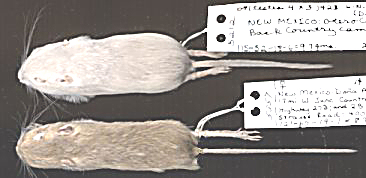

Ever wonder why the same kind of animal looks different when you go from one place to another? Sometimes, they are so different that they are even considered separate subspecies.
Often, the reason is because of geographic isolation--that is, populations are marooned in separate places, with no contact between them. When this happens, each population evolves uninfluenced by others. Even small differences in the environments may select for changes in different directions—and without being together to interbreed, any variations between the populations are preserved.
Good examples are found in the Chihuahuan Desert, where opportunities
for geographic isolation abound. As one example, take the Rock Pocket Mouse in southern
New Mexico. Populations in isolated dark-colored lava beds tend to have dark coats that
blend in well with lava; the same species living in light-colored limestone or
sandstone areas have light-colored coats. Mice which contrast with their background are
much more likely to be seen and picked off by predators, leaving those that better
blend in with their environment to give birth to the next generation.

![]()
Contributor: Arthur H. Harris, Laboratory for Environmental Biology, Centennial Museum, University of Texas at El Paso.
Desert Diary is a joint production of the Centennial Museum and KTEP National Public Radio at the University of Texas at El Paso.

Just as dark-colored mice occur on black lava beds, so do light-colored mice occur on the white gypsum sands of southern New Mexico. Shown are pocket mice from two populations of the same species (Perognathus flavescens). The top specimen is from White Sands, New Mexico; the bottom specimen is from tan, sandy areas of southern New Mexico to the west.
Benson, S. B. 1933. Concealing coloration among some desert rodents of the southwestern United States. University of California Publications in Zoology, 40:1-17.
Dice, L. R. 1947. Effectiveness of selection by owls of deer mice (Peromyscus maniculatus) which contrast in color with their background. Contributions of the Laboratory of Vertebrate Biology, University of Michigan, 34:1-20.
Hooper, E. T. 1941. Mammals of the lava fields and adjoining areas in Valencia County, New Mexico. Miscellaneous Publications, Museum of Zoology, University of Michigan, 51:1-47.
BISON-M account of Chaetodipus intermedius. This is the black species on the lava beds.
BISON-M account of Perognathus flavescens gypsi. This is the nearly white species on White Sands.